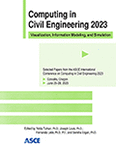LCA Calculation of Retrofitting Scenarios Using Geometric Model Reconstruction and Semantic Enrichment of Point Clouds and Images
Publication: Computing in Civil Engineering 2023
ABSTRACT
To achieve global climate goals, a greater focus needs to be on the energy-efficient conversion of the existing building stock in industrialized countries. To prioritize the retrofitting scenarios of large stocks of existing buildings, holistic life-cycle assessments (LCA) help to consider the environmental impacts in the decision-making. To enable the effortless creation of large building stock information, we propose a methodology to automatically create semantically rich 3D models for calculating the LCA of retrofitting variants. Robustness is achieved by providing flexibility toward input data, for example, geometric reconstruction based on different point clouds, such as laser scans, drone-based photogrammetry, or derived from Google Maps. Similarly, various image sources are used for the semantic enrichment of windows, such as from hand-held devices or Google Street View. Using a case study, we compare the performance of the geometric reconstruction, test window detection, and calculate first LCA results.
Get full access to this article
View all available purchase options and get full access to this chapter.
REFERENCES
BBSR. (2021). “ÖKOBAUDAT.” <https://www.oekobaudat.de/>(Dec. 28, 2021).
Benz, A., Taraben, J., Debus, P., Habte, B., Oppermann, L., Hallermann, N., Voelker, C., Rodehorst, V., and Morgenthal, G. (2021). “Framework for a UAS-based assessment of energy performance of buildings.” Energy and Buildings, 250. 111266. https://doi.org/10.1016/j.enbuild.2021.111266.
Bruno, N., and Roncella, R. (2019). “Accuracy assessment of 3D models generated from Google street view imagery.” Int. Arch. Photogramm. Remote Sens. Spatial Inf. Sci., XLII-2/W9. 181–188. https://doi.org/10.5194/isprs-archives-XLII-2-W9-181-2019.
Busch, R., and Spars, G. (2022). ENOB:dataNWG: Screening des Nichtwohngebäude- bestands <https://www.datanwg.de/downloads/teilberichte/#c348>(Sep. 6, 2022).
CAALA. (2023). “CAALA Software.” <https://caala.de/features>(Mar. 6, 2021).
Chen, Z., Ledoux, H., Khademi, S., and Nan, L. (2022). “Reconstructing compact building models from point clouds using deep implicit fields.” ISPRS Journal of Photogrammetry and Remote Sensing, 194. 58–73. https://doi.org/10.1016/j.isprsjprs.2022.09.017.
Dai, M., Ward, W. O., Meyers, G., Densley Tingley, D., and Mayfield, M. (2021). “Residential building facade segmentation in the urban environment.” Building and Environment, 199. 107921. https://doi.org/10.1016/j.buildenv.2021.107921.
Google. (2023). “Street View of TUM Arcisstraße 21, Munich.” <https://goo.gl/maps/TntrSaX1BWukKPFi9>(Mar. 2, 2023).
Green Building XML. (2023). “gbXML Schema Version 6.01.” <https://gbxml.org/Schema_Current_GreenBuildingXML_gbXML>(Mar. 6, 2023).
Hoegner, L., and Gleixner, G. (2022). “Automatic Extraction of Facades and Windows from MLS Point Clouds using Voxelspace and Visibility Analysis.” Int. Arch. Photogramm. Remote Sens. Spatial Inf. Sci., XLIII-B2-2022. 387–394. https://doi.org/10.5194/isprs-archives-XLIII-B2-2022-387-2022.
Honic, M., Kovacic, I., Gilmutdinov, I., and Wimmer, M. (2020). “Scan to BIM for the Semi-Automated Generation of a Material Passport for an Existing Building.” In Proc., 37th CIB W78 Conference 2020, CIB W78 Proceedings 338–346.
Liu, H., Li, W., and Zhu, J. (2022). “Translational Symmetry-Aware Facade Parsing for 3-D Building Reconstruction.” IEEE MultiMedia, 29(4). 38–47. https://doi.org/10.1109/MMUL.2022.3195990.
Liu, H., Zhang, J., Zhu, J., and Hoi, S. C. H. (2017). “DeepFacade: A Deep Learning Approach to Facade Parsing.” In Proc., Twenty-Sixth International Joint Conference on Artificial Intelligence, edited by F. Bacchus, and C. Sierra 2301–2307., California.
Loga, T., Diefenback, N., and Stein, B. (2012). Typology Approach for Building Stock Energy Typology Approach for Building Stock Energy Assessment. https://doi.org/10.2172/1000008.
Ma, W., Ma, W., and Xu, S. (2022). “Deep Facade Parsing with Occlusions.” KSII TIIS, 16(2) https://doi.org/10.3837/tiis.2022.02.009.
Nan, L., and Wonka, P. (2017). “PolyFit: Polygonal Surface Reconstruction from Point Clouds.” Proceedings of the IEEE International Conference on Computer Vision., 2372–2380.
Nordmark, N., and Ayenew, M. (2021). Window Detection In Facade Imagery: A Deep Learning Approach Using Mask R-CNN <http://arxiv.org/pdf/2107.10006v1>.
Pan, Y., Braun, A., Brilakis, I., and Borrmann, A. (2022). “Enriching geometric digital twins of buildings with small objects by fusing laser scanning and AI-based image recognition.” Automation in Construction, 140. 104375. https://doi.org/10.1016/j.autcon.2022.104375.
Pantoja-Rosero, B. G., Achanta, R., Kozinski, M., Fua, P., Perez-Cruz, F., and Beyer, K. (2022). “Generating LOD3 building models from structure-from-motion and semantic segmentation.” Automation in Construction, 141. 104430. https://doi.org/10.1016/j.autcon.2022.104430.
Raghu, D., Markopoulou, A., Marengo, M., Neri, I., Chronis, A., and de Wolf, C. (2022). “Enabling Component Reuse from Existing Buildings through Machine Learning, Using Google Street View to Enhance Building Databases.” In Proc., CAADRIA 2022: Post-Carbon, edited by J. van Ameijde, N. Gardner, K. H. Hyun, D. Luo, and U. Sheth, CAADRIA proceedings 577–586.
Schnabel, R., Wahl, R., and Klein, R. (2007). “Efficient RANSAC for Point-Cloud Shape Detection.” Computer Graphics Forum, 26(2). 214–226. https://doi.org/10.1111/j.1467-8659.2007.01016.x.
Selimovic, E., Noichl, F., Forth, K., and Borrmann, A. (2022). “Retrofitting Potential of Building envelopes Based on Semantic Surface Models Derived From Point Clouds.” Journal of Facade Design and Engineering, 10(2). 127–139.
Sun, Y., Malihi, S., Li, H., and Maboudi, M. (2022). “DeepWindows: Windows Instance Segmentation through an Improved Mask R-CNN Using Spatial Attention and Relation Modules.” IJGI, 11(3). 162. https://doi.org/10.3390/ijgi11030162.
Zhang, G., Pan, Y., and Zhang, L. (2022). “Deep learning for detecting building façade elements from images considering prior knowledge.” Automation in Construction, 133. 104016. https://doi.org/10.1016/j.autcon.2021.104016.
Information & Authors
Information
Published In
History
Published online: Jan 25, 2024
ASCE Technical Topics:
- Buildings
- Computer networks
- Computing in civil engineering
- Construction engineering
- Construction management
- Construction methods
- Design (by type)
- Engineering fundamentals
- Existing buildings
- Geometrics
- Highway and road design
- Internet
- Models (by type)
- Rehabilitation
- Structural engineering
- Structural systems
- Structures (by type)
- Three-dimensional models
- Windows
Authors
Metrics & Citations
Metrics
Citations
Download citation
If you have the appropriate software installed, you can download article citation data to the citation manager of your choice. Simply select your manager software from the list below and click Download.
